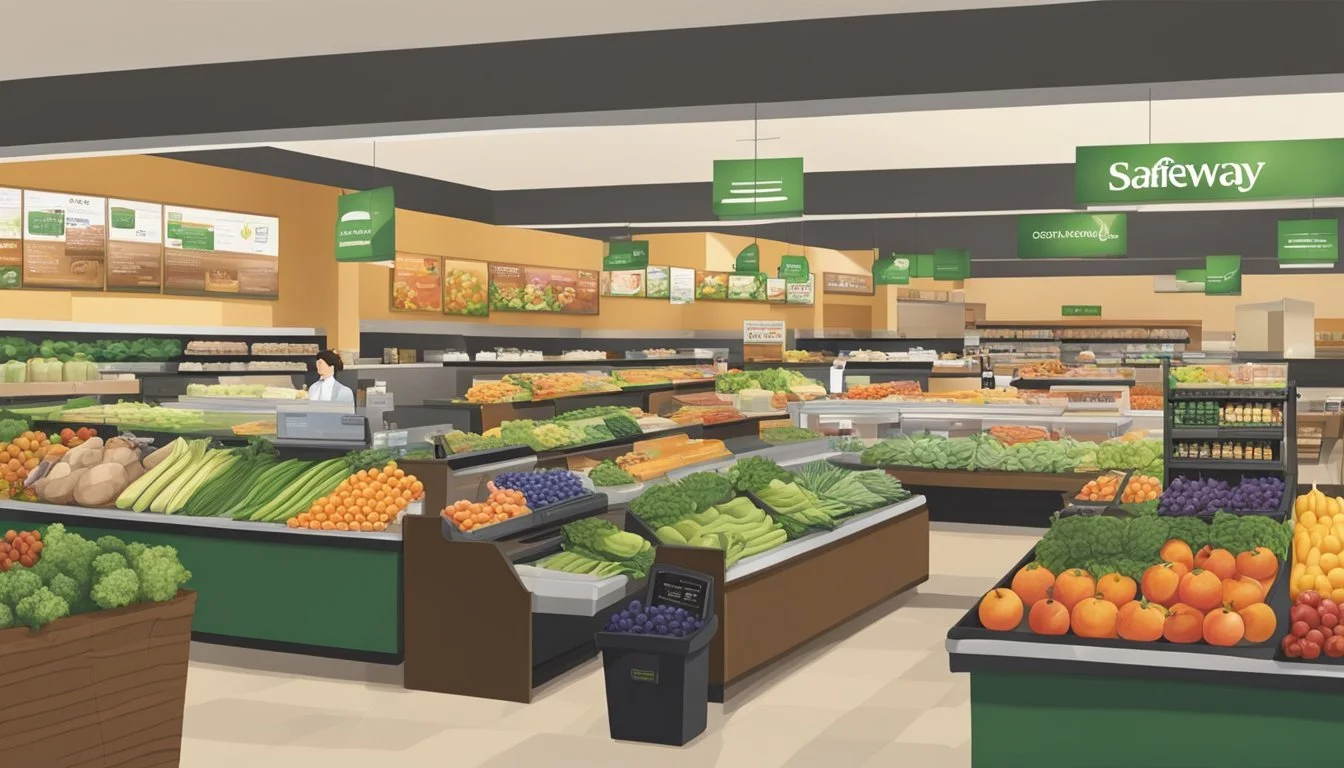Safeway vs Whole Foods
A Comprehensive Comparison of Price, Quality, and Selection
Grocery shopping is a fundamental part of most people's lives, and choosing the right store can significantly impact both budget and lifestyle. Safeway and Whole Foods Market are two prominent grocery chains that often come up in discussions about where to shop. Each store offers a unique experience and caters to different customer preferences.
While Whole Foods is known for its focus on organic and premium products, Safeway provides a more traditional grocery shopping experience with competitive prices. Both stores offer a wide variety of products, but their approaches to quality, pricing, and overall shopping atmosphere differ. Whole Foods tends to attract health-conscious consumers willing to pay more for organic options, while Safeway appeals to a broader customer base seeking everyday groceries at affordable prices.
The choice between Safeway and Whole Foods ultimately depends on individual priorities. Shoppers who prioritize organic and specialty items may prefer Whole Foods, despite potentially higher prices. Those seeking a balance between quality and affordability might find Safeway more suitable for their needs. Both stores have their strengths, and understanding these can help consumers make informed decisions about where to do their grocery shopping.
History and Brand Overview
Safeway and Whole Foods Market have distinctive origins and growth trajectories that shaped their current market positions. Both companies evolved from humble beginnings to become major players in the grocery industry.
Safeway Origins
Safeway's roots trace back to 1915 when M.B. Skaggs purchased a small grocery store in American Falls, Idaho. Skaggs' business philosophy centered on offering value and quality to customers. By 1926, Skaggs had expanded to 428 stores across 10 states. The company incorporated as Safeway in that same year.
Safeway grew rapidly through acquisitions and new store openings. It became the largest grocery chain in the United States during the 1930s. The company pioneered self-service stores and introduced its own private label brands. Safeway's headquarters were established in California, where it maintains a strong presence today.
Whole Foods Evolution
Whole Foods Market began in 1978 when John Mackey and Renee Lawson Hardy opened a small natural foods store called SaferWay in Austin, Texas. In 1980, they partnered with Craig Weller and Mark Skiles to merge SaferWay with Clarksville Natural Grocery, forming the first Whole Foods Market.
The company focused on organic and natural products, differentiating itself from conventional supermarkets. Whole Foods expanded through acquisitions of other natural food chains. It went public in 1992 and continued its growth across the United States.
In 2017, Amazon acquired Whole Foods Market for $13.7 billion, marking a significant shift in the grocery landscape. The merger aimed to combine Whole Foods' high-quality products with Amazon's technology and distribution capabilities.
Store Layout and Design
Safeway and Whole Foods Market employ distinct store layouts that shape the customer experience. Each chain strategically arranges products and sections to optimize shopping efficiency and encourage exploration.
Navigating Safeway Aisles
Safeway typically uses a grid layout with long, parallel aisles. This design maximizes product display and minimizes empty space. Essential items like bread, milk, and eggs are often placed at the store's periphery, prompting customers to traverse multiple sections.
Safeway's shelves are systematically organized, grouping similar products together. Store brand items are prominently featured alongside national brands. The produce section is usually near the entrance, offering a colorful array of fruits and vegetables.
Signage above aisles clearly indicates product categories, making navigation easier. End-cap displays showcase promotional items and seasonal products.
Whole Foods Market Experience
Whole Foods Market opts for an open, airy layout with ample natural lighting. This design creates a welcoming atmosphere and elevated shopping experience. The store's layout encourages exploration and discovery.
The produce section takes center stage, often featuring impressive displays of organic fruits and vegetables. Whole Foods emphasizes its commitment to natural and organic products through prominent signage and informational displays.
Specialty departments, such as the bakery, deli, and prepared foods section, are strategically placed around the store's perimeter. This layout encourages customers to browse these high-margin areas.
Whole Foods' shelves are carefully curated, featuring a mix of premium brands and their own 365 store brand. The layout often includes dedicated spaces for local and artisanal products.
Product Range and Availability
Safeway and Whole Foods offer diverse product selections to cater to different customer preferences. Both stores provide a wide range of groceries, but each has its own unique offerings and focus areas.
Safeway Selection
Safeway stocks a comprehensive array of grocery items, including fresh produce, meat, dairy, and pantry staples. Their produce section features both conventional and organic options, giving customers choice. The meat department offers various cuts and pre-packaged options. Safeway's bakery produces fresh bread, cakes, and pastries daily.
The store carries well-known national brands alongside their own Signature Select line. This private label encompasses everything from canned goods to frozen foods at competitive prices. Safeway also maintains a good selection of international foods to serve diverse communities.
Exclusive Brands at Whole Foods
Whole Foods Market distinguishes itself with a strong focus on natural and organic products. Their produce section boasts an extensive selection of organic fruits and vegetables. The meat counter offers antibiotic-free and grass-fed options.
A standout feature is the 365 by Whole Foods Market brand. This line includes organic pantry staples, frozen foods, and personal care items at more affordable price points. Whole Foods is known for its expansive bulk foods section, allowing customers to purchase exactly the amount they need.
The store excels in specialty items like artisanal cheeses, craft beers, and organic wines. Their bakery produces a variety of organic breads and treats, often using alternative flours and sweeteners.
Quality and Freshness of Products
Product quality and freshness are key factors when comparing grocery stores. Both Whole Foods and Safeway prioritize providing high-quality products, but their approaches and standards differ.
Assessing Whole Foods' Standards
Whole Foods is renowned for its strict quality standards. The store bans over 100 ingredients commonly found in food products, including artificial colors, flavors, and preservatives. Their produce section features an extensive selection of organic fruits and vegetables, often sourced from local farms.
Whole Foods' fresh fruit and vegetable offerings are typically vibrant and well-maintained. The store's commitment to organic and natural products extends to its meat and seafood departments, where items are often antibiotic-free and sustainably sourced.
Prepared foods at Whole Foods are made in-store using high-quality ingredients. The chain's bakery and deli sections offer a wide range of freshly made items daily.
Quality Control at Safeway
Safeway maintains consistent quality across its stores through rigorous quality control measures. The chain sources products from various suppliers and focuses on offering a mix of national brands and its own private label items.
Safeway's produce section typically includes both conventional and organic options. While the selection may not be as extensive as Whole Foods, Safeway strives to provide fresh fruits and vegetables at competitive prices.
The store's meat and seafood departments offer a range of choices, including some organic and natural options. Safeway's bakery produces fresh bread and pastries daily, and its deli section features both pre-packaged and freshly prepared items.
Safeway's private label products undergo strict quality testing to ensure they meet or exceed the quality of national brands.
Pricing Comparison
Comparing prices between Whole Foods Market and Safeway reveals some surprising insights. While Whole Foods has a reputation for higher costs, recent data shows the gap may be narrowing in certain product categories.
Whole Foods Market Pricing Structure
Whole Foods Market's pricing strategy focuses on premium, organic, and natural products. Despite its "Whole Paycheck" nickname, a recent comparison found a basket of 29 common grocery items at Whole Foods cost $125.32. The store emphasizes quality and sustainability, which can impact prices.
Whole Foods offers a range of price points within product categories. For example, eggs vary from affordable store-brand options to pricier organic and specialty varieties. The company has made efforts to improve affordability, especially since its acquisition by Amazon in 2017.
Understanding Safeway's Pricing
Safeway employs a more traditional supermarket pricing model. The same 29-item grocery basket at Safeway totaled $127.98, only $2.66 more than Whole Foods. This narrow gap challenges perceptions of Safeway as the consistently cheaper option.
Safeway's pricing strategy includes:
Regular sales and promotions
A store loyalty program offering additional discounts
A mix of national brands and more affordable store-brand alternatives
While Safeway may have lower prices on some items, it's not universally cheaper across all product categories. Prices for basics like eggs can be higher, with the cheapest carton at $5.99 compared to some competitors' $2.99 options.
Discounts and Savings Programs
Both Safeway and Whole Foods offer attractive discount programs to help customers save money on their grocery purchases. These initiatives aim to provide value and encourage customer loyalty through various rewards and membership benefits.
Rewards and Memberships at Safeway
Safeway's just for U rewards program provides significant savings opportunities for shoppers. Members can access personalized deals and digital coupons through the Safeway app or website. The program often features stackable discounts, such as $5 or $10 off a $50 purchase, potentially leading to savings of up to 30% on a single shopping trip.
Customers can combine just for U deals with manufacturer's coupons for even greater savings. The app allows users to easily clip digital coupons and track their rewards. Safeway's program is free to join and doesn't require a paid membership, making it accessible to all shoppers.
Amazon Prime Benefits at Whole Foods
Whole Foods offers exclusive discounts and perks to Amazon Prime members. Prime subscribers enjoy an additional 10% off sale items throughout the store, marked with yellow signs. They also receive access to special Prime member deals on select products each week.
Prime members can earn 5% back on Whole Foods purchases when using the Amazon Prime Rewards Visa card. The store provides free 2-hour delivery for Prime members in select cities, adding convenience to the savings. To access these benefits, customers simply need to scan their Prime code at checkout or link their phone number to their Amazon account.
Consumer Lifestyle Alignment
Grocery store choices often reflect consumers' values, priorities, and lifestyles. Whole Foods and Safeway cater to different segments of shoppers, each offering unique benefits aligned with specific consumer needs.
Health-Conscious and Eco-Friendly Choices
Whole Foods Market stands out for health-conscious and environmentally aware consumers. The store emphasizes organic produce, sustainably sourced meats, and eco-friendly products.
Whole Foods' commitment to high-quality, natural ingredients appeals to shoppers prioritizing wellness and clean eating. Their extensive selection of plant-based options caters to vegetarians and vegans.
The store's strict standards for artificial additives and preservatives resonate with customers seeking minimally processed foods. Whole Foods also offers a wide range of specialty diet items, including gluten-free, paleo, and keto-friendly products.
Budget-Friendly Shopping Alternatives
Safeway provides a more budget-friendly shopping experience, appealing to cost-conscious consumers. The store offers competitive prices on everyday essentials and staple items.
Safeway's loyalty program and frequent sales help shoppers save money on groceries. Their store-brand products provide quality alternatives at lower price points compared to name brands.
For families and individuals looking to stretch their grocery budget, Safeway's pricing structure often results in significant savings. The store's wide selection of conventional produce and pantry items allows customers to find affordable options across various categories.
Safeway's diverse product range, including both budget and premium choices, caters to shoppers with varying financial priorities. This flexibility enables consumers to balance quality and cost according to their needs.
Competitor Comparison
Safeway and Whole Foods face stiff competition from numerous national and regional grocery chains. These competitors offer varying combinations of price, quality, and selection that appeal to different customer segments.
Supermarket Chains Landscape
Walmart dominates the grocery market with its low prices and vast network of stores. Kroger operates multiple regional brands and competes on value and private label offerings. Costco and Sam's Club attract bulk shoppers with discounted prices.
Aldi and Lidl focus on no-frills shopping experiences and rock-bottom prices. Trader Joe's cultivates a quirky brand and curated product selection. Wegmans emphasizes fresh prepared foods and upscale offerings.
Regional players like Publix in the Southeast and Hy-Vee in the Midwest maintain strong customer loyalty. Sprouts Farmers Market and Albertsons position themselves between conventional and natural/organic grocers.
Discount chains Food Lion and Winn-Dixie compete primarily on price in their respective regions. Harris Teeter targets more affluent shoppers with higher-end products and services.
Location and Accessibility
Safeway and Whole Foods Market differ in their store locations and accessibility. Both chains have distinct strategies for where they place their stores and how customers can reach them.
Regional Stores and Urban Accessibility
Safeway operates over 900 stores across the western and mid-Atlantic regions of the United States. The chain focuses on suburban areas and smaller cities, making it easily accessible for many households.
Whole Foods Market has fewer locations, with around 500 stores primarily in urban and affluent suburban areas. The company targets health-conscious consumers in metropolitan regions.
In Austin, Texas, Whole Foods Market maintains a strong presence as it was founded there. The city boasts multiple Whole Foods locations, including its flagship store and global headquarters.
Safeway doesn't have stores in Austin, as its parent company Albertsons focuses on other regions. This limits options for Austin residents seeking Safeway's offerings.
Both chains offer online ordering and delivery services, expanding their accessibility beyond physical store locations. This allows customers to shop from home, bridging gaps in geographic coverage.
Consumer Services and Experience
Safeway and Whole Foods offer distinct shopping experiences tailored to different consumer preferences. Both chains provide a range of in-store services and online shopping options to meet diverse customer needs.
In-Store Services
Safeway emphasizes convenience with its pharmacy services, offering prescription fills and immunizations. Many locations feature deli counters, bakeries, and floral departments. Whole Foods focuses on specialty offerings like cheese mongers, wine experts, and prepared food stations. Both stores provide self-checkout options.
Safeway's loyalty program offers personalized deals and gas rewards. Whole Foods integrates with Amazon Prime for exclusive discounts. Product sampling is more common at Whole Foods, allowing customers to try specialty items before purchasing.
Online Shopping and Delivery
Both chains have embraced e-commerce, offering online shopping and delivery services. Safeway partners with Instacart for same-day delivery in many areas. Their website and mobile app allow for easy ordering of pantry staples and fresh goods.
Whole Foods leverages Amazon's infrastructure for efficient delivery. Prime members enjoy free two-hour delivery on orders over $35 in select cities. Their online platform showcases a wide product variety, including hard-to-find specialty items.
Safeway's online experience focuses on everyday essentials for families. Whole Foods' digital storefront highlights organic and premium products. Both offer pickup options for added flexibility.






